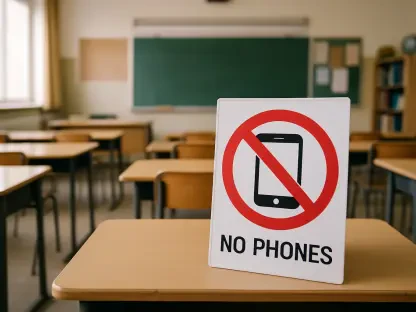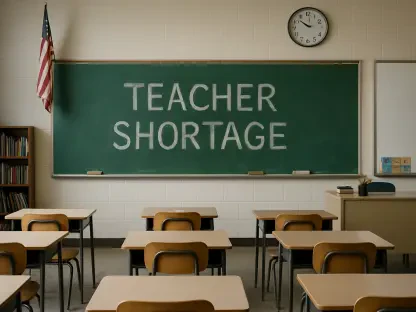Elementary school educators across Kansas are preparing for a significant shift in their professional development as they face the introduction of required literacy classes. Esteemed institutions, such as the University of Kansas (KU), other five Regents universities, and Washburn University in Topeka, are on the verge of starting pivotal science of reading classes aimed at enhancing the reading skills of elementary students. This statewide initiative is an essential move to address the concerning statistic that over 30% of Kansas elementary students are reading below their grade level.
Mandatory Training and Certification
New Certification Requirements
Elementary school teachers, counselors, and principals—totaling more than 15,000 educators—are required to get certification in new reading teaching methods. This requirement is part of their license renewal by the Kansas State Department of Education, starting July 2028. The new certification process emphasizes a deep understanding of phonics and how the brain processes reading tasks, a departure from conventional reading strategies that often encouraged students to skip challenging words and use context clues.
The new certification requirements ensure that educators are equipped with contemporary methods that are better aligned with scientific findings about how children learn to read. This shift signifies a robust overhaul aimed at making literacy education more effective, allowing educators to foster a solid foundation in reading for their students. By mandating this certification, Kansas aims to standardize high-quality reading instruction across all elementary schools in the state, ensuring every student has access to effective reading education.
Impact on Educators
The mandate affects a wide range of educators, including those who traditionally might not focus on literacy, such as art, physical education, health education, and music teachers. This inclusive approach ensures that all educators are equipped with the skills to support literacy development in their students. The comprehensive nature of the training aims to create a unified approach to reading education across the state.
For educators, the requirement to integrate literacy training into their professional development may seem daunting, particularly for those whose primary focus lies outside traditional reading instruction. However, this move underscores the importance of literacy as a foundational skill that intersects with all areas of education. By involving all educators, Kansas acknowledges the multifaceted nature of literacy development and the critical role all teachers play in fostering reading skills. The goal is to create a holistic educational environment where literacy is seamlessly supported across various subjects.
The Science of Reading
Emphasis on Phonics
The new methods being introduced emphasize a deep understanding of phonics and how the brain processes reading tasks. This approach is a significant shift from previous strategies that often encouraged students to skip challenging words and use context clues. By focusing on phonics, educators can help students develop a stronger foundation in reading, which is crucial for their overall academic success.
Phonics instruction is a research-backed method that aids students in decoding words by understanding the relationship between letters and sounds. Emphasizing phonics helps students improve their reading accuracy and fluency, providing a more solid base for developing comprehension skills. The implementation of phonics-based methods ensures that students are better equipped to understand and engage with texts, giving them the confidence to tackle more complex reading materials as they progress in their education.
Tailored Curriculum
Kansas has taken the initiative to specifically tailor this program to its educators. The curriculum is designed to address the unique challenges faced by Kansas students and to provide educators with the tools they need to improve literacy rates. This tailored approach ensures that the training is relevant and impactful, directly addressing the literacy challenges within the state.
The curriculum considers specific demographic and regional factors that influence literacy development among Kansas students. By customizing the program, Kansas educators receive training that is directly applicable to their classrooms, making the interventions more effective. The flexibility within the curriculum allows for adjustments based on feedback and results, promoting continuous improvement in reading education across the state. This tailored approach is expected to yield significant improvements in literacy rates, helping students achieve their full academic potential.
Program Roll-Out
Course Structure
The University of Kansas and other notable institutions will begin offering six-credit-hour courses dedicated to these new methods beginning in June. The courses will merge online and in-person engagements, incorporating classroom demonstrations to ensure teachers can apply their learning directly with students. This blended approach allows educators to balance their professional development with their existing responsibilities.
The structure of the courses is designed to be flexible and reachable, considering that many educators juggle various duties. Online components provide convenience, while in-person sessions offer hands-on experience and immediate application of newly acquired skills. Incorporating classroom demonstrations ensures that teachers can see the effectiveness of these methods in real-life settings, which is crucial for practical learning. This combination of online and in-person learning optimizes the training process, making it accessible and effective for all educators involved.
Centers for Excellence in Reading
To support the implementation of the new methods, centers for excellence in reading will be set up across the Regents universities. These centers will provide in-person support and classroom implementation, ensuring that educators have access to the resources they need to succeed. The centers will also serve as hubs for ongoing professional development and collaboration among educators.
The Centers for Excellence in Reading are intended to be focal points for innovation and support in literacy education throughout Kansas. By offering in-person assistance, these centers ensure that teachers can seek help and guidance as they implement new reading strategies in their classrooms. Additionally, these centers will foster a community of educators dedicated to improving literacy, allowing for the exchange of ideas and best practices. This collaborative environment is essential for the ongoing development of effective reading instruction methods and sustaining the momentum of the state’s literacy initiative.
Funds and Incentives
Financial Support
To support the educators, the Kansas Legislature allocated $2.7 million to cover tuition costs for these courses and added a $500 stipend for each educator completing the courses. This financial support is crucial in ensuring that all educators have access to the training, regardless of their financial situation. However, this funding is contingent upon annual approval from the Legislature and the governor, making it prudent for educators to take advantage of the current resources.
The allocation of funds demonstrates the state’s commitment to addressing literacy issues proactively. By subsidizing tuition and providing stipends, Kansas removes financial barriers that could prevent educators from participating in the program. This approach not only incentivizes participation but also acknowledges the significant effort required by teachers to undertake additional training. Despite the reliance on annual funding approvals, the initial financial investment highlights the priority Kansas places on improving literacy education and supporting its educators.
Budget Allocation
The Kansas Board of Regents has set the tuition rate at $300 per credit hour, meaning the full six-hour course costs $1,800. This allows the budget to cover tuition for about 1,500 educators per year. Despite this, online training sessions, already underway for the past year, provide additional avenues for certification. The course structure includes centers set up across the Regents universities for in-person support and classroom implementation.
The budget allocation efficiently maximizes the number of educators who can benefit from the program within the constraints of available funding. It also encourages prompt action from educators to enroll in the courses while funding is available. Online training sessions supplement the in-person courses, extending the program’s reach and flexibility. By offering multiple certification avenues, Kansas ensures that the initiative is adaptable to various schedules and needs, further promoting widespread participation in the literacy training endeavor.
Logistics and Reach
Flexible Training Options
There is a significant emphasis on flexibility, with different universities offering varying schedules and methods of delivering the training. This adaptability is crucial to accommodate the working schedules of educators. The blended approach of online and in-person training ensures that all educators can participate, regardless of their location or time constraints.
The flexible training options underscore the program’s inclusivity, allowing educators to select the mode of learning that best fits their personal and professional lives. This consideration is particularly important for those working in rural areas, where access to in-person training may be limited. By providing both online and in-person opportunities, the program makes comprehensive literacy education attainable for all educators in Kansas, facilitating widespread adoption and implementation of new reading methods.
Ongoing Support
The program’s inclusive nature, considering art, physical education, health education, and music teachers, also manifests a pragmatic stance in focusing efforts on educators directly impacting literacy skills. The ongoing support provided by the centers for excellence in reading ensures that educators have access to the resources they need to continue improving their teaching methods.
Ongoing support is essential for sustaining the effectiveness of the new literacy strategies. The Centers for Excellence in Reading offer continuous professional development opportunities and a support network for educators. This environment of ongoing learning and collaboration enhances the implementation process, ensuring that teachers remain well-equipped to foster literacy skills in their students. The sustained support further cements the program’s long-term impact on improving reading capabilities among Kansas students.
Overarching Trends and Consensus Viewpoints
Shift to Rigorous Literacy Training
The state’s move towards rigorous literacy training manifests an understanding that the existing methods are insufficient for the growing number of students reading below grade level. The commitment to enhancing literacy rates is evident in the structured, comprehensive training program designed for educators. This shift is expected to have a profound impact on students’ reading capabilities and overall academic success.
Recognizing the deficiencies in traditional reading instruction, Kansas is taking a bold step to revamp its approach to literacy education. The rigorous training program grounded in the science of reading will equip educators with effective techniques backed by research. This transformation is anticipated to significantly elevate students’ reading abilities, ultimately improving their broader academic performance and opportunities for future success.
Financial Support with Uncertainty
Although the legislature has provided financial backing for the initial rollout, the annual nature of funding approval introduces an element of uncertainty. This planning reflects a cautious optimism, urging educators to take full advantage of the current resources.
The annual review of financial support introduces a level of unpredictability, necessitating strategic planning by educators and institutions. While the immediate financial backing is a strong start, the dependency on yearly approvals requires educators to act swiftly and make the most of available resources. This uncertainty underlines the importance of continuous advocacy for sustained funding to ensure the long-term success and stability of the literacy training program.
Conclusion
Elementary school teachers across Kansas are gearing up for a major change in their professional development with the introduction of mandatory literacy courses. Renowned institutions like the University of Kansas (KU), the other five Regents universities, and Washburn University in Topeka are all set to offer key classes focused on the science of reading. These classes aim to improve the reading proficiency of elementary students throughout the state. This initiative is vital in addressing the alarming fact that over 30% of Kansas elementary students are currently reading below their grade level.
The move to strengthen educators’ understanding of reading science reflects a broad effort to tackle literacy issues at their root. By offering in-depth training, these universities hope to equip teachers with innovative and effective strategies to help young learners excel in reading. Such an initiative is not just a response to current statistics but a proactive step towards ensuring that future generations of students can achieve better academic outcomes.
This educational reform is expected to bring long-term benefits, equipping educators with the latest strategies and knowledge. It underscores the importance of continuous professional development in the ever-evolving landscape of education. Kansas is taking an important step by investing in its teachers, recognizing that their expertise is crucial for student success and for uplifting educational standards across the state. By addressing literacy challenges head-on, Kansas aims for a brighter academic future for its elementary students.









